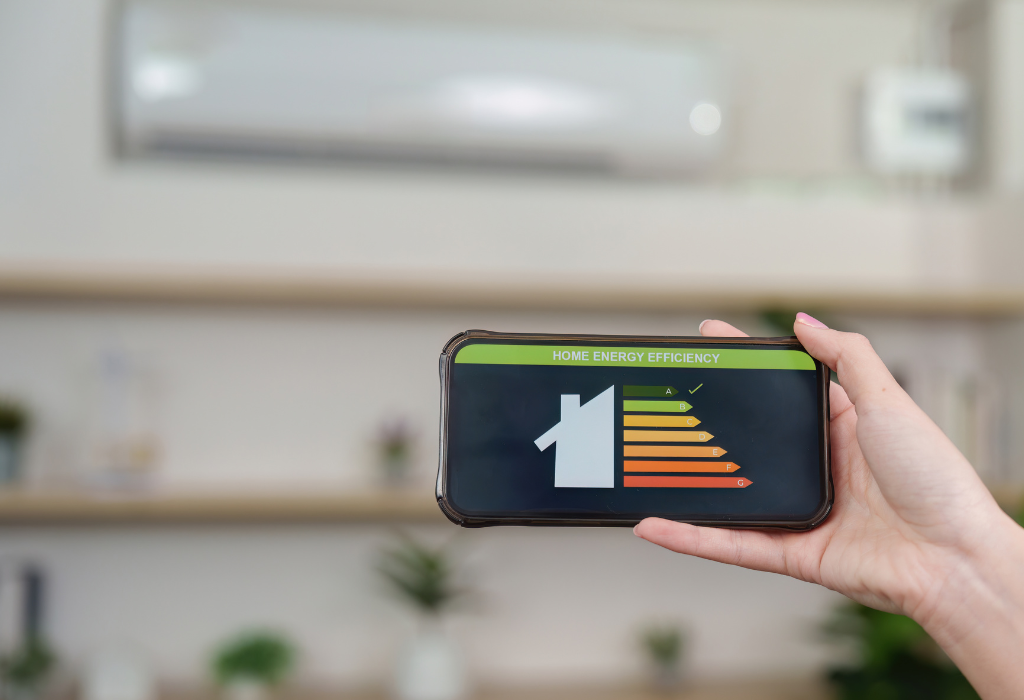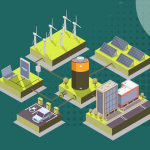Smart homes have moved beyond convenience, shifting their focus to sustainable living and conscious consumption. Home automation is a powerful tool for homeowners who want to control their energy use, reduce their carbon footprint and cut their utility bills. The great news is that you don’t need to renovate your place to enjoy these benefits. You can get them one smart technology at a time, starting with these eco-friendly upgrades.
1. Smart Thermostats for Energy-Efficient HVAC Systems
Residential buildings account for about 20% of primary power use in America, with nearly half used for space cooling and heating. Smart thermostats can significantly reduce that consumption.
These devices can automate a home’s cooling and heating. Ones like the Google Nest can learn a household’s temperature patterns over time. They automatically create and implement a schedule that minimizes electricity use without sacrificing comfort.
Advanced smart thermostats have geofencing technology, which uses your smartphone’s location to determine whether you’re in or out of your home. If you’re out of range, it’ll switch the HVAC system to energy-saving “away” mode. It’ll automatically return to a more comfortable temperature once you get home.

2. Smart Vents for Zoned Climate Control
Smart vents are another home automation must-have. These internet-connected vent covers automatically open and close to regulate airflow and provide room-by-room temperature control. They work best with a smart thermostat.
The vents can communicate with smart thermostats and remote temperature sensors in the same room. They can direct airflow only to rooms you have specified, open or close if they detect someone has entered a room, and correct hot and cold spots. With smart vents, you can stop paying to heat or cool empty guest rooms, storage areas and other unused spaces.
Your HVAC system can also run more efficiently and for shorter periods, as it no longer has to overwork to achieve the right temperature in one stubborn room. Advanced smart vents also come equipped with pressure sensors to ensure they never close too many at once.

3. Smart LED Lighting and Plugs for Energy Savings
LED lighting uses at least 75% less power than incandescent lighting. Optimizing it with smart technology can amplify these savings. For example, you can schedule all the lights to turn off at bedtime and use motion sensors to illuminate hallways. Selecting fixtures with dimming capabilities can also reduce electricity consumption.
Meanwhile, smart plugs can eliminate “vampire power” or “phantom load,” which is the energy devices consume even when they’re turned off. Common culprits include phone chargers and entertainment systems. Smart plugs can act as an automated gatekeeper, cutting off power completely based on a schedule or command.

4. Smart Water Management for Conservation
Installing water-efficient fixtures can reduce your water consumption by at least 20%, but you can save more with smart home upgrades. A smart sprinkler system works beyond simple timers. It can also tap in to local weather data and automatically skip watering sessions before, during or after it rains.
Investing in smart leak detectors for sinks, water heaters and washing machines can help you spot costly leaks early. When these devices detect moisture in areas where it shouldn’t be, they send instant alerts so you can investigate. Advanced systems can even trigger the automatic shut-off valve to prevent further damage and water waste.

5. Home Energy Monitors for Visible Consumption
Whether you have multiple smart home upgrades or simply want to track your energy consumption, a home energy monitor is a great investment. These devices provide a real-time, granular breakdown of where electricity is being used. Install them into your home’s electrical panel, and they’ll use machine learning to identify and track the unique electrical signature of your appliances.
Home energy monitors turn abstract power use into a definite, manageable metric. Use their data to spot electricity hogs and malfunctioning appliances. Address the issues accordingly — whether that involves limiting use or getting a more efficient replacement — and you’ll soon see positive changes in your consumption.
To further enhance your home’s efficiency, consider using these monitoring devices in conjunction with a unified smart home system. Advanced centralized hubs — which make managing smart devices simpler — often record the consumption of the applications and devices they control. Compare and combine their data to empower your energy-saving practices.

6. Automated Window Treatments for Strategic Natural Light
Here’s a sophisticated way to manage your home’s temperature with natural light. Automated window treatments are window coverings — such as curtains, blinds or shades — that you can automatically open, close or adjust using integrated smart home technology.
Motorized window coverings can help your HVAC system regulate room temperatures. For example, you can schedule south-facing windows to open during the day to let in natural light and passive heat, and close them at dusk to trap the warmth. Automated window treatments can also help you maximize natural light and reduce the need for artificial lighting.

7. Smart Appliances for the Greener Household Management
Many modern smart appliances have eco-friendly features. For example, some advanced refrigerators have internal cameras and inventory-tracking apps to help homeowners avoid duplicate purchases and reduce food waste. Smart dishwashers and washing machines can be scheduled to run during off-peak energy hours, when electricity is cheaper and grid demand is lower. Some even have sensors that adjust water and power use based on the load size.

8. Automated Composters for Reduced Food Waste
Approximately 30% to 40% of the food supply in America is wasted, with 31% of the loss occurring at the consumer level. When food scraps decompose in landfills, they produce methane, which is a potent greenhouse gas. To help mitigate this issue, consider minimizing your food waste with an automated composter.
You can add a wide variety of food scraps to the composter. Then, the device uses a controlled process of heating, aeration and grinding to create a dry, nutrient-dense fertilizer. You can use it for your houseplants, garden or lawn, reducing the need for chemical fertilizers.
9. Automated Garage Door System for Energy Efficiency
The garage can be a major source of energy loss, especially if it’s uninsulated. You disrupt its temperature every time you open or close it to access your vehicle, and that can affect the rest of your home. Fortunately, home automation and smart upgrades can make your garage more energy-efficient.
A smart garage door system is crucial for effective energy management, to the point that 70% of owners consider it a must-have home feature. This technology ensures the door is only accessible at specific times and is never accidentally left open, preventing conditioned air from escaping. It also offers helpful features like remote monitoring, hands-free operation, detailed activity logs and automated locking.

10. On-Site Energy Storage for Optimized Energy Use
Harnessing renewable electricity through solar panels is beneficial for the environment, and you can maximize them with smart battery systems. These systems are programmable, so they can charge during the day or from the grid at night when rates are lowest.
If you have stored power, you can use it during expensive peak demand hours to save money and reduce strain on the grid. Explore various energy storage solutions to determine which one best suits your needs.

11. Smart Grid Optimization for Community Collaboration
A fully automated home can become an active participant in a larger energy grid. Some utility companies utilize smart grid technologies to enhance the efficiency of their systems. They may also offer financial incentives to homeowners who agree to let them adjust their home system and temporarily reduce their energy use during peak demand hours and events. For example, on a hot summer afternoon, utility personnel may adjust your smart thermostat by a couple of degrees for a short period to prevent a blackout.
Build Your Sustainable Home With Smart Home Upgrades
Living more sustainably is easier with these smart technologies. Thankfully, they’re fairly readily available, and often for a reasonable price. Creating an entire smart home may be expensive to do all at once, but going slowly lets you use what you recoup to make further investments.
Start with one or combine several key upgrades. Invest in compatible technologies you can control from a single device for convenience to create an automated, efficient ecosystem that saves money, reduces waste and contributes to a healthier planet.
Frequently Asked Questions
What smart home upgrade saves the most energy?
While it varies depending on the home, a smart thermostat typically offers the most significant savings. It optimizes heating and cooling, which can account for nearly half of a house’s energy use. By learning your habits and adjusting the temperature settings as necessary, this device helps prevent energy waste.
Do you need a central hub for your smart home?
You don’t, as many upgrades can be controlled individually via their own apps. However, as you build up your home ecosystem with smart devices, having a central hub or platform like Google Home or Apple HomeKit can create a more seamless and automated system.
Are smart home devices secure?
Reputable smart device brands ensure security in their products through features such as data encryption and two-factor authentication. Use strong, unique passwords and keep your device firmware up to date to protect your home network. Apply these safety practices to all your upgrades to reinforce their security.
References
Science Direct: A critical review of use cases and insights from a large dataset of smart thermostats
US Department of Energy: LED LIGHTING
EPA: Water Statistics and Facts
USDA: Food Waste FAQs





